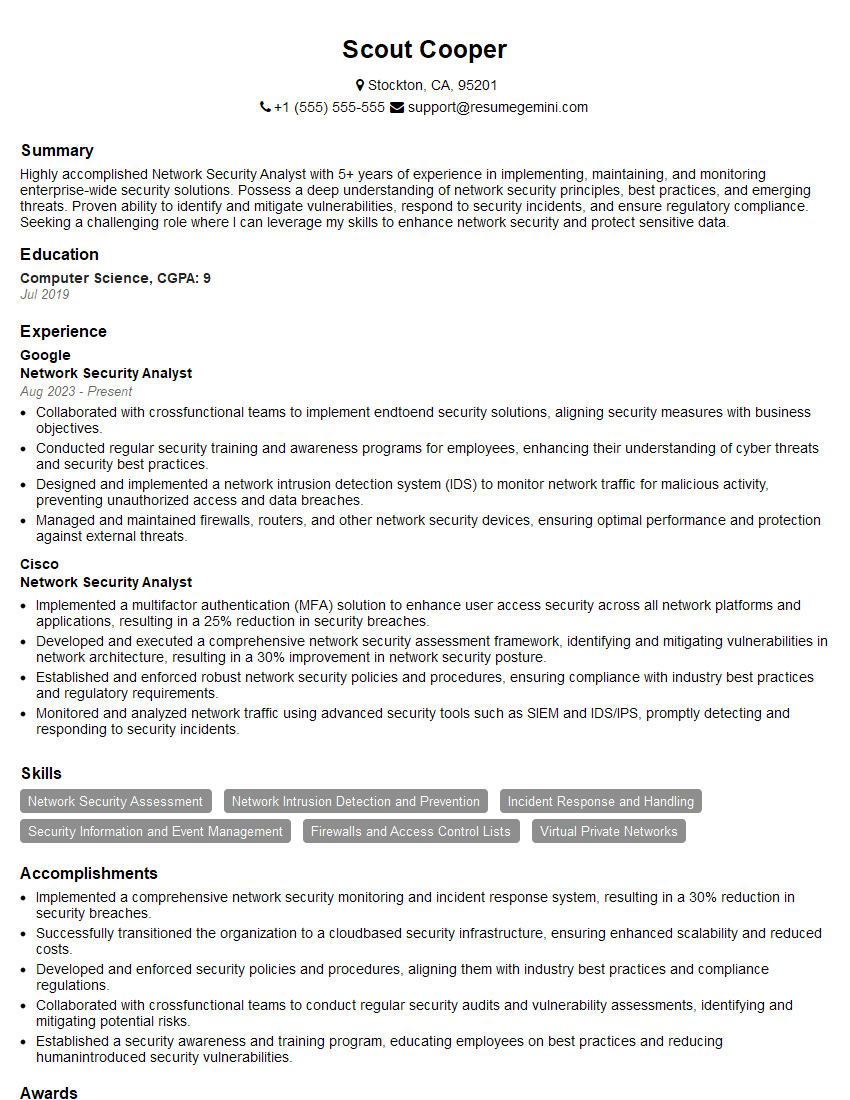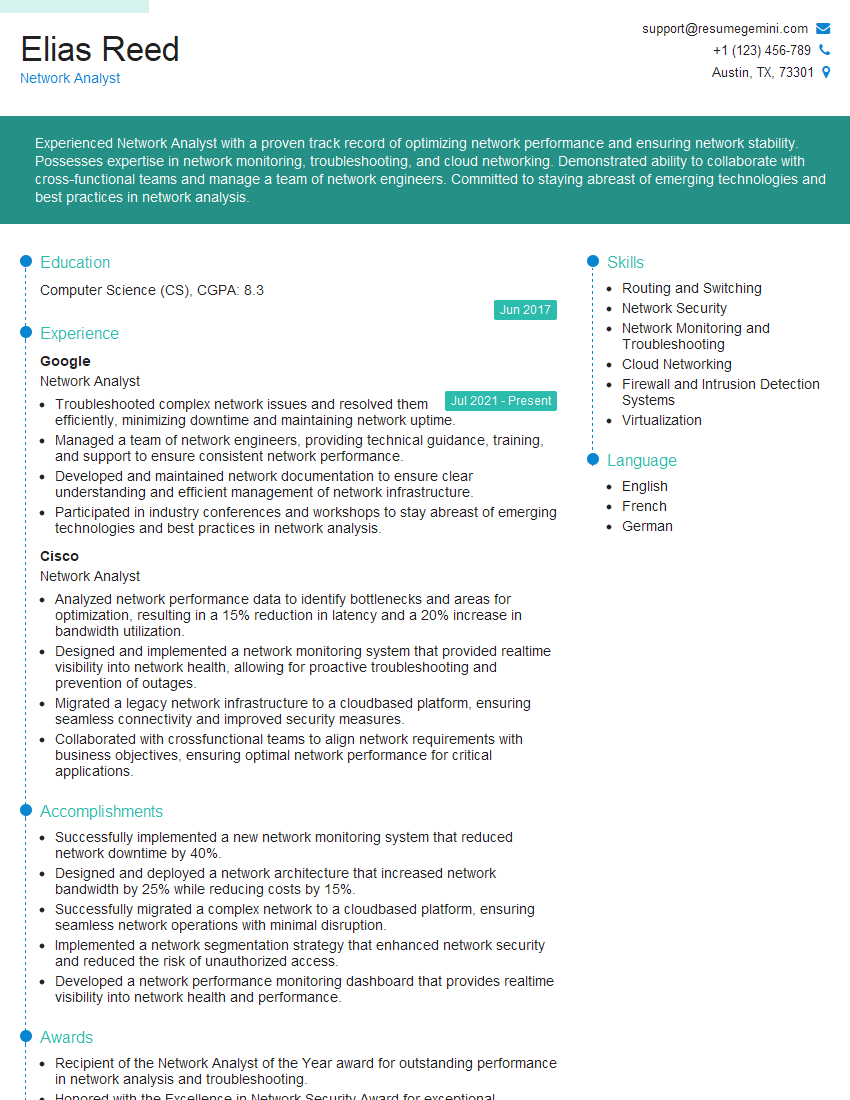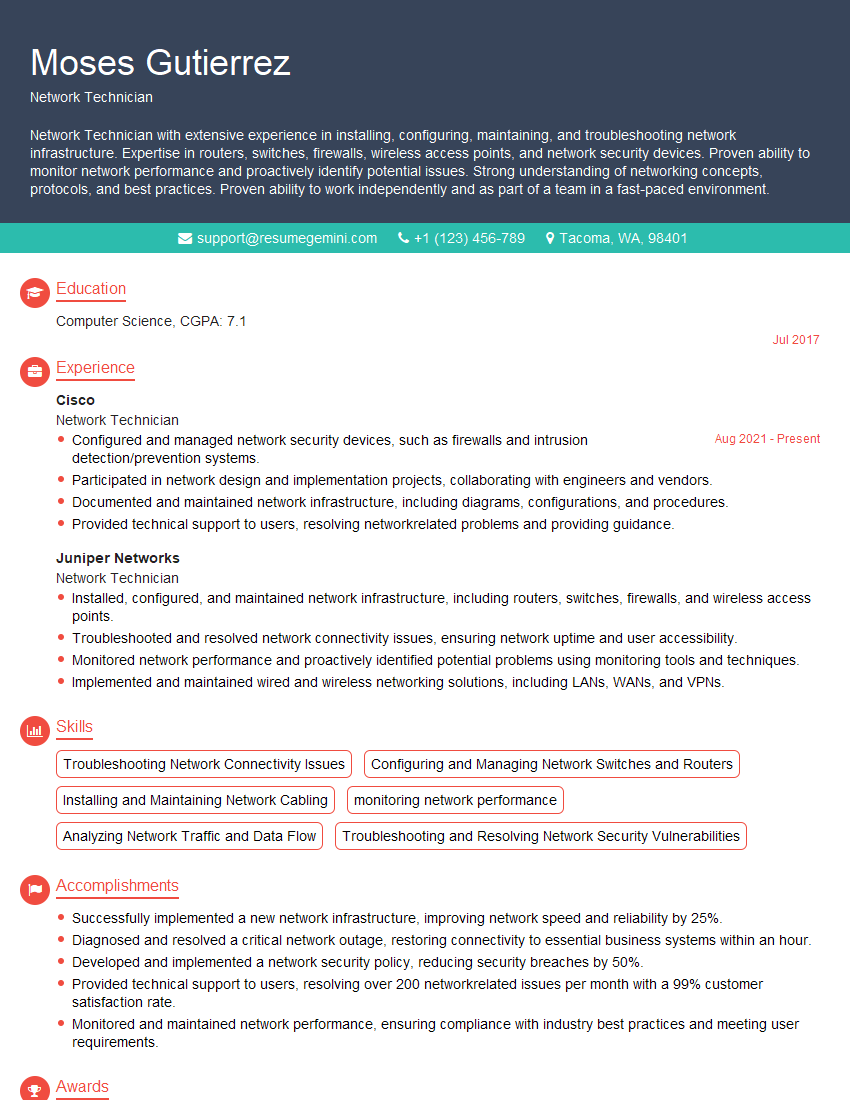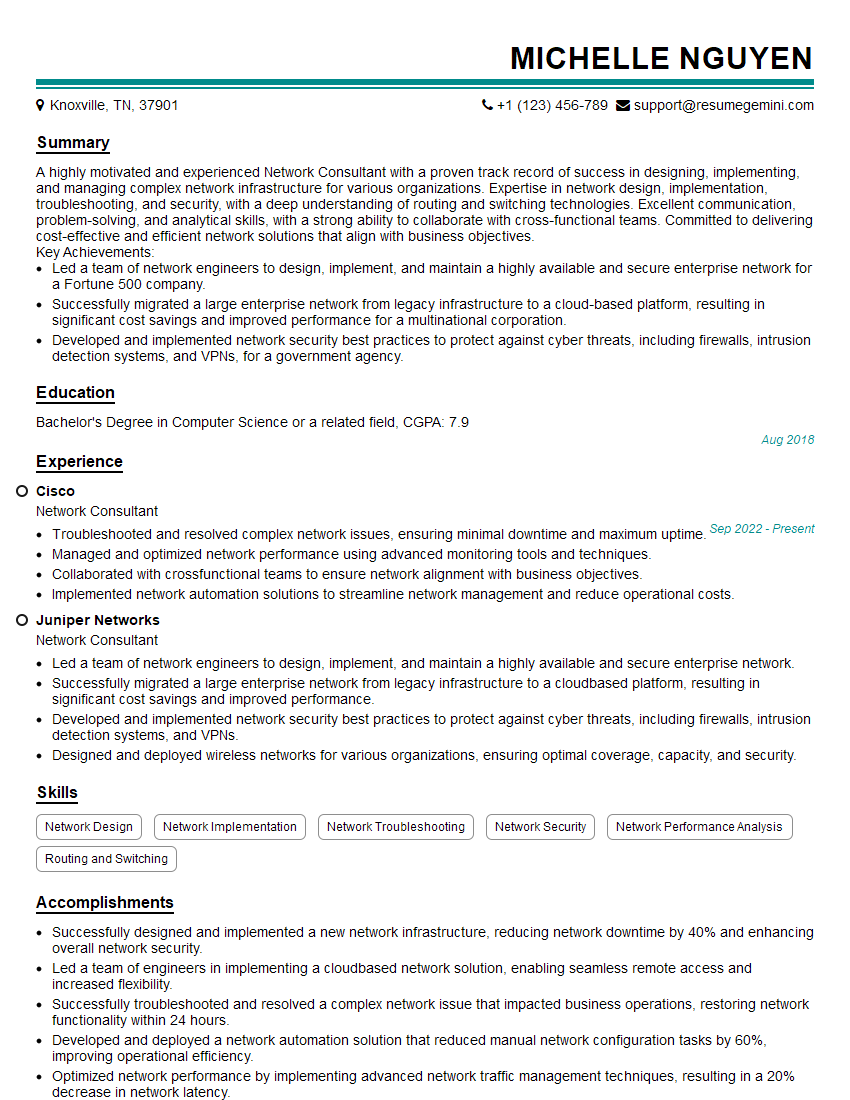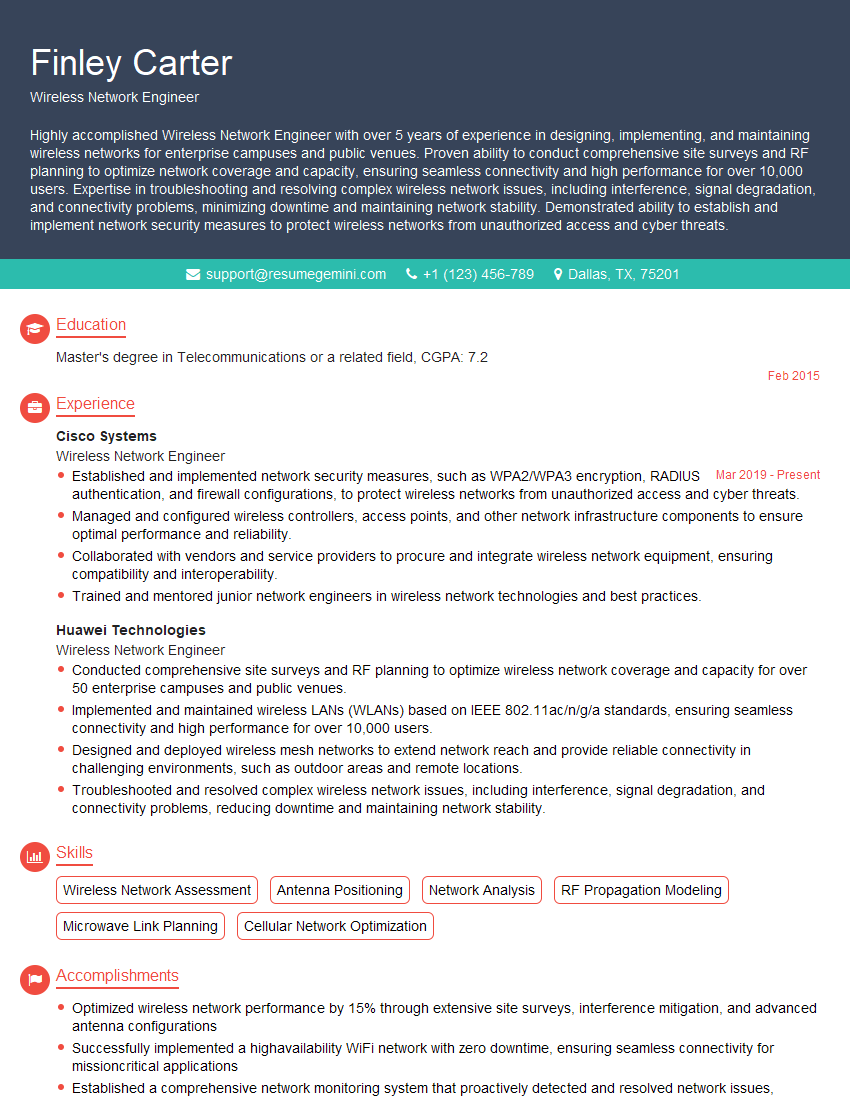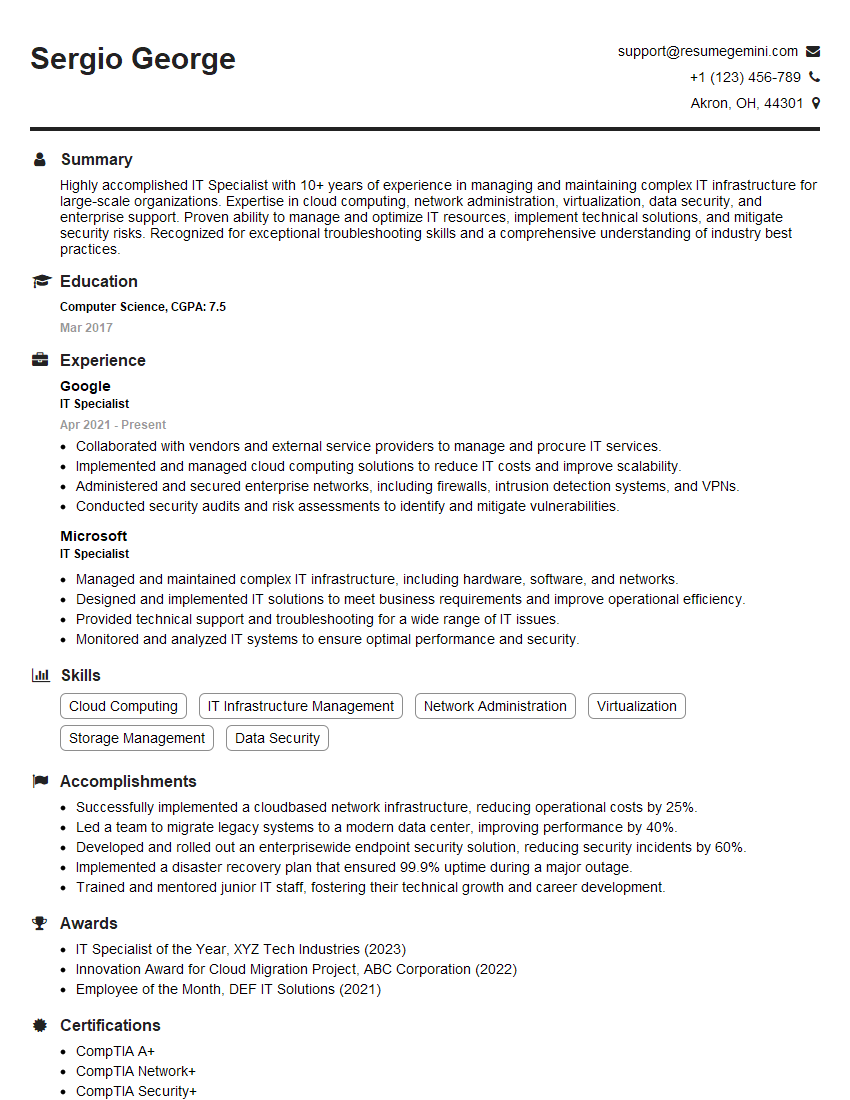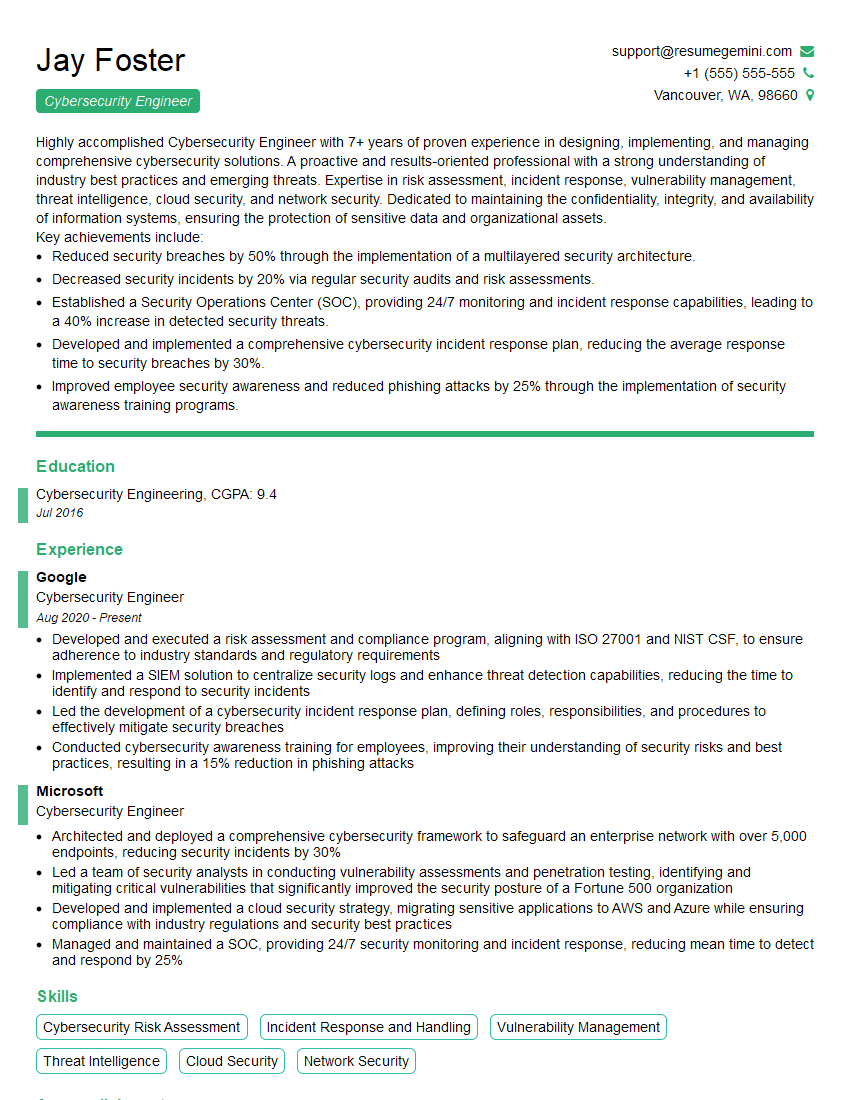The right preparation can turn an interview into an opportunity to showcase your expertise. This guide to Expertise in deploying and troubleshooting network applications interview questions is your ultimate resource, providing key insights and tips to help you ace your responses and stand out as a top candidate.
Questions Asked in Expertise in deploying and troubleshooting network applications Interview
Q 1. Explain the TCP/IP model.
The TCP/IP model is a suite of communication protocols that governs how data is transmitted over the internet. Think of it as a layered cake, where each layer has a specific role in ensuring reliable data delivery. It’s not a strict model like the OSI model, but rather a more practical representation of how the internet works.
Application Layer: This is where applications like web browsers (HTTP), email clients (SMTP, POP3, IMAP), and file transfer programs (FTP) interact with the network. It handles the data’s meaning and format.
Transport Layer: This layer provides reliable data delivery services. TCP (Transmission Control Protocol) ensures reliable, ordered data delivery by acknowledging receipt and retransmitting lost packets. UDP (User Datagram Protocol) provides a connectionless, faster, but less reliable service, prioritizing speed over guaranteed delivery. Examples include streaming services using UDP for speed and VoIP applications.
Internet Layer (Network Layer): This layer handles the routing of data packets across networks. It uses IP addresses to determine the destination of each packet. IP routing protocols, like RIP and OSPF, work here.
Network Access Layer (Link Layer): This is the lowest layer, responsible for the physical transmission of data over the network medium (e.g., Ethernet cables, Wi-Fi). MAC addresses operate at this layer, enabling communication within a local network.
Imagine sending a letter: the application layer is what you write, the transport layer is the envelope ensuring safe arrival, the internet layer is the postal service determining the route, and the network access layer is the truck delivering the letter to your local post office.
Q 2. Describe the difference between TCP and UDP.
TCP and UDP are both transport layer protocols in the TCP/IP model, but they differ significantly in their approach to data delivery:
TCP (Transmission Control Protocol): TCP is connection-oriented, meaning it establishes a connection between sender and receiver before transmitting data. It guarantees reliable, ordered delivery through acknowledgments and retransmissions. Think of it as sending a registered letter – you know it’s received and in order.
UDP (User Datagram Protocol): UDP is connectionless. It doesn’t establish a connection and doesn’t guarantee delivery or order. It’s faster but less reliable. Imagine sending a postcard – it might arrive, it might not, and it might arrive out of order.
In summary:
| Feature | TCP | UDP |
|---|---|---|
| Connection | Connection-oriented | Connectionless |
| Reliability | Reliable | Unreliable |
| Order | Ordered | Unordered |
| Speed | Slower | Faster |
| Overhead | Higher | Lower |
TCP is ideal for applications requiring reliable data transfer, like web browsing and email. UDP is suitable for applications where speed is crucial and some data loss is acceptable, such as online gaming and video streaming.
Q 3. What are common network topologies?
Network topologies describe the physical or logical layout of nodes (computers, printers, etc.) and connections in a network. Common topologies include:
Bus Topology: All devices connect to a single cable. Simple to implement but a single point of failure.
Star Topology: All devices connect to a central hub or switch. Easy to manage and expand, but the central device is a single point of failure.
Ring Topology: Devices are connected in a closed loop. Data travels in one direction. Failure of one device can disrupt the entire network.
Mesh Topology: Devices connect to multiple other devices, creating redundant paths. Highly reliable but complex to manage.
Tree Topology: A hierarchical structure, resembling an inverted tree. Combines features of bus and star topologies.
Most modern networks utilize a star topology due to its scalability and manageability. Internet service providers (ISPs) often use mesh topologies for redundancy and fault tolerance. The choice of topology depends on the network’s size, requirements, and budget.
Q 4. How do you troubleshoot network connectivity issues?
Troubleshooting network connectivity issues requires a systematic approach. I typically follow these steps:
Identify the problem: Is the issue affecting a single device, a group of devices, or the entire network? What are the symptoms (e.g., no internet access, slow speeds, intermittent connectivity)?
Check the basics: Ensure cables are properly connected, devices are powered on, and Wi-Fi is enabled (if applicable). Test with a different cable or device if possible.
Ping the device/gateway: Use the
pingcommand (available on most operating systems) to test connectivity. For example,ping 8.8.8.8(Google’s public DNS server) checks internet connectivity. A successful ping shows connectivity. Failure indicates a problem somewhere between the device and the target.Check IP configuration: Verify the device has a valid IP address, subnet mask, and default gateway. Incorrect IP configuration can prevent connectivity.
Check DNS resolution: If you can ping the gateway but not access websites, there might be a DNS issue. Try using a different DNS server (e.g., 8.8.8.8 or 8.8.4.4).
Check firewall settings: Firewalls can block network traffic. Temporarily disable the firewall (carefully!) to see if it resolves the issue.
Trace the route (traceroute): The
traceroutecommand shows the path data takes to reach a destination. It helps identify points of failure along the route.Check network devices: If the issue is network-wide, examine routers, switches, and other network devices. Look for error messages or unusual activity.
Consult logs: Examine logs on network devices and the affected computers for error messages or clues.
Remember to document your steps and findings to aid future troubleshooting. Using tools like Wireshark for packet analysis can provide detailed insights into network traffic for more complex problems.
Q 5. Explain the concept of subnetting.
Subnetting divides a larger network (IP address range) into smaller, more manageable subnetworks. This improves network efficiency and security. It’s like dividing a large apartment building into smaller apartments; each with its own access.
The process involves borrowing bits from the host portion of an IP address to create additional network bits. This creates multiple subnets, each with its own network address and broadcast address. Using subnet masks, we define the boundary between network and host portions.
For example, a Class C network (192.168.1.0/24) has 254 usable host addresses. Subnetting with a /25 subnet mask (255.255.255.128) divides it into two subnets, each with 126 usable host addresses. A /26 mask would create four subnets, each with 62 usable addresses, and so on.
Subnetting improves network performance by reducing broadcast traffic and improves security by limiting the scope of broadcast domains. Careful subnet planning is crucial for efficient network design and management. Incorrect subnetting can cause connectivity problems.
Q 6. What is a VLAN and how is it used?
A VLAN (Virtual Local Area Network) is a logical grouping of devices on a network that acts like a separate physical network. It’s like having multiple apartments within a single building, where each apartment functions independently but uses shared infrastructure.
VLANs use tagging mechanisms to identify which VLAN a particular frame (data packet) belongs to. Devices in the same VLAN can communicate directly, while devices in different VLANs are separated unless explicitly configured to communicate across VLANs using routers or inter-VLAN routing methods.
Uses of VLANs:
Improved security: Isolating sensitive data by placing them on separate VLANs.
Enhanced performance: Reducing broadcast domain sizes improves network performance by lowering broadcast traffic.
Flexibility: Allows physical separation of network segments without physical changes. You can group users or devices logically regardless of their physical location.
Simplified management: Facilitates easier management of large networks by creating logical groupings of devices based on function or department.
VLANs are configured using switches capable of VLAN tagging (IEEE 802.1Q tagging). VLANs are widely used in modern enterprise networks to improve network performance and security.
Q 7. How do you diagnose and resolve DNS issues?
Diagnosing and resolving DNS issues involves a systematic approach to pinpointing the source of the problem.
Check DNS server configuration: Ensure that the devices are using the correct DNS server IP addresses. These are typically provided by your ISP or network administrator.
Check DNS server availability: Use the
pingcommand to check if you can reach the DNS server. If not, there’s a problem with network connectivity to your DNS server.Use
nslookupordig: These commands allow you to query the DNS server directly. For example,nslookup google.comwill attempt to resolve the domain name. Errors during resolution pinpoint the specific problem.Check local DNS cache: Your computer may have a cached entry that is incorrect. Clearing the DNS cache can force it to re-query the server.
Check for DNS server overload: If the server is overloaded, it might be slow to respond or not respond at all. Monitor the server’s load and resources.
Check for DNS record issues: If the domain name doesn’t exist or has incorrect records (e.g., wrong IP address), the problem is with the DNS records themselves, requiring changes to be made at the domain registrar.
Check for network issues: Problems with network connectivity (firewall, routing issues) can also prevent DNS resolution.
By systematically checking each of these aspects, you can identify the exact cause of DNS issues and implement the necessary corrections. If the problem persists, consulting your ISP or domain registrar might be necessary.
Q 8. Describe your experience with network monitoring tools.
Network monitoring is crucial for maintaining a healthy and efficient network infrastructure. My experience spans various tools, from simple command-line utilities like ping and traceroute to sophisticated solutions like Nagios, Zabbix, and SolarWinds. I’m proficient in using these tools to monitor key metrics such as bandwidth utilization, latency, packet loss, CPU usage on network devices, and application performance.
For instance, in a previous role, we used Nagios to monitor our entire network infrastructure, including servers, routers, and switches. We configured it to send alerts via email and SMS when critical thresholds were breached, allowing for proactive issue resolution. This prevented major outages and significantly reduced downtime. I’m also experienced in setting up dashboards for visualizing key metrics, making it easy to identify trends and potential problems before they escalate.
Beyond the tools themselves, I understand the importance of choosing the right monitoring solution based on the specific needs of the network. This involves considering factors like the size of the network, the types of devices being monitored, the budget, and the desired level of granularity in the monitoring data.
Q 9. Explain your experience with firewalls and security protocols.
Firewalls are the first line of defense in network security, acting as gatekeepers to control network traffic based on predefined rules. I have extensive experience with various firewall types, including hardware firewalls (e.g., Cisco ASA, Fortinet), and software firewalls (e.g., iptables, Windows Firewall). My expertise extends to configuring and managing firewalls to implement security protocols such as IPv4/IPv6 filtering, Access Control Lists (ACLs), VPNs, and Intrusion Prevention Systems (IPS).
Security protocols are the backbone of network security. I’m proficient in implementing and troubleshooting protocols such as TLS/SSL for secure communication, SSH for secure remote access, and IPsec for securing VPN connections. For example, I once resolved a security breach by identifying misconfigured firewall rules that allowed unauthorized access to a sensitive server. The solution involved tightening the firewall rules and implementing stronger authentication measures.
Understanding the interplay between firewalls and security protocols is crucial for creating a robust security posture. For instance, using IPsec VPNs in conjunction with carefully configured firewall rules provides a layered approach to network security, protecting both internal and external network segments.
Q 10. How do you handle network security incidents?
Handling network security incidents requires a structured approach. My process involves the following steps:
- Identify and contain the incident: This involves isolating the affected systems to prevent further damage or spread of the incident. This might involve disconnecting affected devices from the network or blocking malicious traffic at the firewall level.
- Analyze the incident: This involves investigating the root cause of the incident. This often includes reviewing logs from firewalls, servers, and other network devices to identify the source of the attack, the affected systems, and the extent of the damage.
- Eradicate the threat: This involves removing the malicious code or software, patching vulnerabilities, and resetting compromised accounts.
- Recover the system: This involves restoring affected systems to their operational state, which might involve restoring backups or reinstalling software.
- Post-incident analysis: After the immediate crisis is resolved, a thorough analysis should be conducted to determine how the incident happened, identifying weaknesses in the security infrastructure, and implementing measures to prevent future occurrences.
For instance, in one case, we experienced a Distributed Denial of Service (DDoS) attack. We immediately mitigated the attack using a combination of techniques including rate limiting at the firewall, and utilizing a cloud-based DDoS mitigation service. Post-incident, we strengthened our firewall rules and implemented more robust DDoS protection measures.
Q 11. Describe your experience with routing protocols (e.g., BGP, OSPF).
Routing protocols are essential for directing network traffic between different networks. I have hands-on experience with both interior gateway protocols (IGPs) like OSPF (Open Shortest Path First) and exterior gateway protocols (EGPs) like BGP (Border Gateway Protocol).
OSPF is a link-state routing protocol commonly used within an autonomous system (AS). I’ve configured OSPF on Cisco and Juniper routers, understanding concepts like area configurations, routing summarization, and the impact of different OSPF metrics on route selection. For example, I optimized network performance by carefully configuring OSPF areas to reduce routing overhead in a large enterprise network.
BGP is a path-vector protocol used for routing between autonomous systems. My experience includes configuring BGP on border routers to exchange routing information with other networks. This includes configuring BGP attributes such as AS path, next-hop, and community attributes to control route selection. I’ve also tackled issues with BGP convergence and troubleshooting BGP routing issues.
Understanding the strengths and weaknesses of different routing protocols is crucial for choosing the right protocol for a given network. For instance, OSPF is ideal for smaller, well-defined networks, while BGP is essential for large, complex networks involving multiple autonomous systems.
Q 12. What is QoS and how is it implemented?
Quality of Service (QoS) is a set of networking capabilities that allow administrators to manage the type of traffic traversing a network, allowing them to prioritize certain types of data streams over others. This is crucial in networks where different applications have varying bandwidth and latency requirements.
QoS is implemented through various techniques, including:
- Traffic classification: Identifying and classifying network traffic based on factors like protocol, port number, or application. This could be achieved using tools like packet inspection.
- Traffic shaping: Controlling the rate at which traffic is sent, preventing congestion and ensuring fair sharing of bandwidth.
- Traffic prioritization: Assigning different priorities to different types of traffic, ensuring that critical applications receive preferential treatment.
- Queue management: Managing queues of packets waiting to be transmitted, prioritizing high-priority packets over low-priority ones.
For example, in a VoIP network, QoS is essential to ensure that voice traffic is prioritized over other data traffic to minimize jitter and latency, resulting in high-quality voice communication. This often involves using techniques like DiffServ or MPLS.
Q 13. Explain your experience with load balancing.
Load balancing distributes network traffic across multiple servers, preventing overload on any single server and ensuring high availability. My experience covers various load balancing techniques, including:
- DNS-based load balancing: Distributing traffic across multiple servers by using different DNS records.
- Layer 4 load balancing: Distributing traffic based on TCP/UDP ports.
- Layer 7 load balancing: Distributing traffic based on application-layer data (HTTP headers, etc.).
I’ve worked with both hardware and software load balancers, such as F5 BIG-IP, HAProxy, and Nginx. In one project, we implemented a Layer 7 load balancer to distribute web traffic across multiple web servers, ensuring high availability and performance for our website, even during peak loads. Proper configuration of health checks is crucial to ensure that only healthy servers receive traffic, preventing users from connecting to failing servers.
Q 14. Describe your experience with VPNs.
VPNs (Virtual Private Networks) create secure connections over public networks, allowing users to access private networks remotely. I’m familiar with various VPN technologies, including IPsec, SSL/TLS, and OpenVPN. I’ve configured and managed VPNs on both routers and servers.
My experience includes setting up site-to-site VPNs to connect different office locations securely, as well as remote access VPNs for employees to access the corporate network from remote locations. This includes configuring VPN tunnels, authentication mechanisms, and encryption protocols to ensure data confidentiality and integrity.
Security is paramount when implementing VPNs. I pay close attention to ensuring strong encryption algorithms are used, proper authentication methods are implemented, and VPN configurations are regularly audited to prevent vulnerabilities. For example, in one instance, I implemented multi-factor authentication on our VPN to enhance security and prevent unauthorized access.
Q 15. How do you manage network bandwidth effectively?
Effective network bandwidth management is crucial for optimal application performance and user experience. It involves a multi-pronged approach focusing on monitoring, optimization, and control.
Monitoring: Regularly monitoring bandwidth usage using tools like network monitoring software (e.g., SolarWinds, PRTG) helps identify periods of high utilization and pinpoint bandwidth-intensive applications or users. This data reveals patterns and allows for proactive adjustments.
Optimization: Optimizing network traffic involves several strategies. Quality of Service (QoS) prioritizes critical traffic (like VoIP or video conferencing) over less critical traffic (like file transfers). Traffic shaping limits the bandwidth allocated to specific applications or users, preventing them from hogging resources. Bandwidth throttling reduces the speed of bandwidth-heavy activities during peak times.
Control: Implementing network access control (NAC) can regulate user access and restrict bandwidth usage based on roles or devices. This prevents unauthorized access and limits potential bandwidth abuse. Regularly reviewing and updating network configurations ensures optimal bandwidth allocation.
Example: In a previous role, we used QoS to prioritize VoIP calls during peak hours in a call center, ensuring clear communication even when network congestion was high. This significantly improved customer satisfaction and agent productivity.
Career Expert Tips:
- Ace those interviews! Prepare effectively by reviewing the Top 50 Most Common Interview Questions on ResumeGemini.
- Navigate your job search with confidence! Explore a wide range of Career Tips on ResumeGemini. Learn about common challenges and recommendations to overcome them.
- Craft the perfect resume! Master the Art of Resume Writing with ResumeGemini’s guide. Showcase your unique qualifications and achievements effectively.
- Don’t miss out on holiday savings! Build your dream resume with ResumeGemini’s ATS optimized templates.
Q 16. Explain your experience with network automation tools.
I have extensive experience with several network automation tools, primarily Ansible and Terraform. Ansible excels in automating repetitive configuration tasks across multiple devices, enabling efficient and consistent deployments. Terraform allows for infrastructure-as-code, defining and managing network infrastructure in a declarative manner. This approach streamlines provisioning and updates, minimizing human error.
Ansible Example: I used Ansible to automate the configuration of hundreds of network switches with a single playbook, ensuring consistent security settings and VLAN configurations across our entire network. This drastically reduced deployment time and improved consistency.
Terraform Example: In a cloud project, I leveraged Terraform to provision and manage virtual networks, subnets, and security groups in AWS. This automated the entire infrastructure setup, simplifying deployment and enabling rapid scalability.
Q 17. Describe a complex network troubleshooting scenario you faced and how you resolved it.
I once encountered a situation where a critical application experienced intermittent connectivity issues. Initial troubleshooting pointed towards network latency, but the cause remained elusive. After extensive packet capture analysis using Wireshark, I discovered that a specific VLAN was experiencing high packet loss at a particular switch port. Further investigation revealed a faulty cable causing intermittent connectivity.
Troubleshooting Steps:
- Identified the Problem: Intermittent connectivity affecting a critical application.
- Gathered Information: Analyzed network monitoring data, conducted ping tests, and performed traceroutes.
- Isolated the Issue: Used Wireshark to pinpoint high packet loss on a specific VLAN and switch port.
- Determined the Root Cause: Physical inspection of cabling revealed a faulty cable.
- Implemented the Solution: Replaced the faulty cable.
- Validated the Solution: Verified application connectivity and monitored network performance.
This experience highlighted the importance of meticulous investigation and the use of specialized tools like Wireshark in network troubleshooting. The seemingly simple solution – replacing a cable – was only discovered after a thorough process of elimination and detailed analysis.
Q 18. What are common network performance bottlenecks?
Network performance bottlenecks can stem from various sources. Identifying and addressing these bottlenecks is key to optimizing network performance.
Insufficient Bandwidth: A network with insufficient bandwidth cannot handle the traffic volume, resulting in slowdowns and congestion. This is often addressed by upgrading network infrastructure or optimizing traffic.
Overutilized Devices: Overloaded routers, switches, or firewalls can become bottlenecks, causing delays and packet loss. Upgrading hardware or optimizing device configurations can mitigate this.
Slow Links: Slow network links, such as outdated cabling or wireless connections, can create significant performance bottlenecks. Upgrading to faster technologies or improving the physical infrastructure is necessary.
Inefficient Routing: Poorly planned routing protocols or routing tables can lead to inefficient traffic flow, increasing latency and reducing performance. Optimizing routing protocols and configurations improves network efficiency.
Application Issues: Inefficiently designed applications or poorly configured applications can consume excessive bandwidth or resources, creating performance bottlenecks. Optimizing the applications themselves or limiting their resource consumption is crucial.
Q 19. How do you ensure network security and compliance?
Ensuring network security and compliance involves a layered approach combining technological and procedural measures. This includes:
Firewalls: Implementing robust firewalls to control network access and prevent unauthorized connections.
Intrusion Detection/Prevention Systems (IDS/IPS): Deploying IDS/IPS to monitor network traffic for malicious activity and block or alert on suspicious patterns.
Virtual Private Networks (VPNs): Using VPNs to secure remote access and encrypt sensitive data transmitted over public networks.
Access Control Lists (ACLs): Implementing ACLs to restrict access to specific network resources based on user roles and permissions.
Regular Security Audits and Penetration Testing: Conducting regular security audits and penetration testing to identify vulnerabilities and ensure compliance with industry standards and regulations.
Security Information and Event Management (SIEM): Utilizing SIEM systems for centralized log management and security event correlation, providing enhanced visibility into network activity.
Compliance: Adherence to regulations like GDPR, HIPAA, or PCI DSS requires careful consideration of data protection, access control, and auditing practices. Documentation of security policies and procedures is essential for demonstrating compliance.
Q 20. What is your experience with cloud networking platforms (e.g., AWS, Azure, GCP)?
I possess considerable experience with cloud networking platforms, including AWS, Azure, and GCP. I’ve worked extensively with virtual networks, subnets, load balancers, and other cloud networking services. My experience includes designing, deploying, and managing highly available and scalable network architectures in the cloud.
AWS Example: I designed and implemented a highly available architecture using AWS VPC, EC2 instances, and Elastic Load Balancing to support a large-scale web application. This included implementing auto-scaling and security groups to ensure optimal performance and security.
Azure Example: I used Azure Virtual Network and Azure Load Balancer to deploy a multi-tier application, leveraging Azure’s features for traffic management and high availability. This experience involved configuring network security groups and implementing appropriate routing policies.
GCP Example: In a project involving GCP, I utilized Google Cloud Virtual Network (VPC) and Cloud Load Balancing to create a resilient and scalable network infrastructure for a data processing pipeline.
Q 21. Explain your understanding of network segmentation.
Network segmentation divides a large network into smaller, isolated segments. This improves security by limiting the impact of a security breach. If one segment is compromised, the attacker’s access is restricted to that segment, preventing widespread damage.
Benefits of Network Segmentation:
- Enhanced Security: Limits the blast radius of security incidents.
- Improved Performance: Reduces network congestion by isolating traffic.
- Better Compliance: Helps meet regulatory requirements for data separation.
- Easier Troubleshooting: Simplifies identification and resolution of network issues.
Implementation: Network segmentation is typically achieved using VLANs (Virtual LANs), firewalls, and other security devices. VLANs logically separate devices on the same physical network, while firewalls control traffic flow between segments.
Example: A company might segment its network into segments for different departments (e.g., Marketing, Sales, HR), isolating sensitive data and limiting potential damage from internal or external threats.
Q 22. Describe your experience with network virtualization.
Network virtualization is the process of creating virtual representations of network hardware and software, allowing for greater flexibility, scalability, and efficiency. Think of it like having virtual machines for your network, instead of only physical devices. This allows you to create and manage networks independent of the underlying physical infrastructure.
My experience includes deploying and managing virtual networks using VMware NSX and Cisco ACI. In one project, we used NSX to create isolated virtual networks for different departments within a large organization, improving security and resource allocation. We also leveraged NSX’s micro-segmentation capabilities to enhance security by controlling traffic flow within the virtualized environment. This resulted in a more agile and secure network infrastructure that could adapt to changing business needs quickly.
Furthermore, I’ve worked with OpenStack Neutron, a versatile network virtualization platform, enabling the creation and management of virtual networks within cloud environments. This involved configuring virtual routers, switches, and firewalls to provide comprehensive network connectivity and security.
Q 23. What is your experience with IP addressing schemes (IPv4, IPv6)?
IP addressing is the system used to assign unique addresses to devices on a network, allowing them to communicate. IPv4 uses 32-bit addresses (e.g., 192.168.1.1), while IPv6 uses 128-bit addresses (e.g., 2001:0db8:85a3:0000:0000:8a2e:0370:7334), providing significantly more addresses. Understanding subnetting and CIDR notation is crucial for efficient IP address allocation.
My experience encompasses both IPv4 and IPv6 addressing schemes. I’ve designed and implemented complex IPv4 subnets using CIDR notation, ensuring efficient address allocation for large networks. I’ve also been involved in migrating networks from IPv4 to IPv6, addressing the challenges of dual-stack deployments and transition mechanisms like NAT64 and DNS64. For example, during a recent migration, we implemented a phased approach, initially deploying IPv6 alongside IPv4, and then gradually transitioning to IPv6-only for newer services.
Q 24. How do you perform network capacity planning?
Network capacity planning involves forecasting future network needs and designing a network infrastructure that can handle anticipated growth. It’s about ensuring your network can meet current and future demands without performance degradation.
My approach involves analyzing historical network data, including traffic patterns, bandwidth usage, and device utilization. I use tools like SolarWinds or PRTG to monitor network performance and identify potential bottlenecks. Based on this data, I project future growth and determine the necessary network upgrades. This includes forecasting bandwidth requirements, assessing the need for additional network devices (routers, switches, etc.), and planning for potential expansion of the network infrastructure. For example, in a recent project for an e-commerce company, we projected a significant increase in traffic during peak seasons. This led us to implement traffic shaping techniques and plan for additional bandwidth to prevent service disruptions.
Q 25. What are your preferred methods for documenting network configurations?
Effective documentation is essential for managing and troubleshooting networks. My preferred methods include using a combination of network diagrams, configuration management tools, and a central knowledge base.
I use tools like Visio or draw.io to create clear and concise network diagrams that visually represent the network topology, including devices, connections, and IP addressing schemes. Configuration management tools like Ansible or Puppet allow me to automate the configuration of network devices and maintain a consistent and auditable record of changes. Finally, I maintain a central knowledge base, typically a wiki, to store network documentation, troubleshooting guides, and other relevant information.
This multi-faceted approach ensures that network configurations are well-documented, easily accessible, and maintainable. It reduces downtime caused by configuration errors and allows for easier onboarding of new team members.
Q 26. Explain your experience with network management systems (NMS).
Network Management Systems (NMS) are software applications that provide centralized monitoring and management of network devices and infrastructure. They are crucial for ensuring network performance, security, and availability.
My experience includes working with various NMS tools, including SolarWinds Network Performance Monitor, PRTG Network Monitor, and Nagios. I have used these systems to monitor network performance metrics (bandwidth utilization, latency, packet loss), detect and alert on potential issues, and manage network configurations. For instance, I implemented alerts for critical network issues, such as high CPU utilization on routers or significant packet loss on links. These alerts allow for prompt identification and resolution of problems, minimizing disruptions to network services.
Q 27. Describe your experience with network device configuration and management.
Configuring and managing network devices, such as routers, switches, and firewalls, requires a deep understanding of networking protocols and best practices. This involves tasks such as IP address assignment, routing protocol configuration, access control list (ACL) implementation, and quality of service (QoS) settings.
My experience spans various vendors and technologies, including Cisco IOS, Juniper JunOS, and various Linux distributions used in network infrastructure. I’m proficient in using command-line interfaces (CLIs) to configure devices and employ automation tools like Ansible to manage configurations across multiple devices. For example, I’ve implemented complex routing protocols like OSPF and BGP to build redundant and scalable networks. I also have experience with implementing security policies using firewalls and ACLs to protect the network from unauthorized access.
Q 28. How do you stay current with the latest network technologies?
The field of networking is constantly evolving, so staying current is crucial. My approach is multifaceted.
Firstly, I actively participate in online communities and forums, such as those dedicated to specific networking technologies (e.g., Cisco, Juniper). I engage in discussions, share knowledge, and learn from others’ experiences. Secondly, I regularly attend industry conferences and webinars, and subscribe to relevant newsletters and publications to stay updated on the latest trends and innovations. Finally, I dedicate time to hands-on experimentation and self-study through online courses and certifications. This combination of active participation and self-directed learning ensures I remain up-to-date on the latest networking technologies and best practices.
Key Topics to Learn for Expertise in deploying and troubleshooting network applications Interview
- Network Protocols: Understanding TCP/IP, UDP, HTTP, HTTPS, DNS, and their practical implications in application deployment and troubleshooting. Consider scenarios where protocol limitations impact application performance.
- Network Security: Familiarize yourself with firewalls, intrusion detection/prevention systems, VPNs, and security best practices for deploying and securing network applications. Be prepared to discuss security considerations during the deployment process.
- Cloud Platforms (AWS, Azure, GCP): Gain proficiency in deploying and managing applications on at least one major cloud platform. Practice troubleshooting common cloud-related issues such as connectivity problems and resource limitations.
- Virtualization and Containerization: Understand the benefits and challenges of deploying applications using virtualization technologies (e.g., VMware, Hyper-V) and containerization (e.g., Docker, Kubernetes). Be ready to discuss orchestration and scalability.
- Network Monitoring and Troubleshooting Tools: Become proficient with tools like Wireshark, tcpdump, ping, traceroute, and network monitoring platforms. Practice diagnosing network issues using these tools and explain your problem-solving approach.
- Load Balancing and High Availability: Understand the principles of load balancing and high availability and how they ensure application resilience and scalability. Be able to discuss different load balancing techniques and their use cases.
- Application Deployment Methodologies: Familiarize yourself with various deployment methods (e.g., blue/green deployments, canary deployments, rolling updates) and their advantages and disadvantages. Be prepared to discuss the best approach for different scenarios.
- Performance Optimization: Understand techniques for optimizing network application performance, including identifying bottlenecks and implementing solutions to improve speed and efficiency.
Next Steps
Mastering expertise in deploying and troubleshooting network applications is crucial for career advancement in today’s technology-driven world. It opens doors to exciting roles with high earning potential and significant responsibility. To maximize your job prospects, create an ATS-friendly resume that showcases your skills and experience effectively. ResumeGemini is a trusted resource that can help you build a professional and impactful resume. We provide examples of resumes tailored to expertise in deploying and troubleshooting network applications to help you get started. Invest the time to craft a compelling narrative, and you’ll significantly increase your chances of landing your dream job.
Explore more articles
Users Rating of Our Blogs
Share Your Experience
We value your feedback! Please rate our content and share your thoughts (optional).
What Readers Say About Our Blog
Hello,
We found issues with your domain’s email setup that may be sending your messages to spam or blocking them completely. InboxShield Mini shows you how to fix it in minutes — no tech skills required.
Scan your domain now for details: https://inboxshield-mini.com/
— Adam @ InboxShield Mini
Reply STOP to unsubscribe
Hi, are you owner of interviewgemini.com? What if I told you I could help you find extra time in your schedule, reconnect with leads you didn’t even realize you missed, and bring in more “I want to work with you” conversations, without increasing your ad spend or hiring a full-time employee?
All with a flexible, budget-friendly service that could easily pay for itself. Sounds good?
Would it be nice to jump on a quick 10-minute call so I can show you exactly how we make this work?
Best,
Hapei
Marketing Director
Hey, I know you’re the owner of interviewgemini.com. I’ll be quick.
Fundraising for your business is tough and time-consuming. We make it easier by guaranteeing two private investor meetings each month, for six months. No demos, no pitch events – just direct introductions to active investors matched to your startup.
If youR17;re raising, this could help you build real momentum. Want me to send more info?
Hi, I represent an SEO company that specialises in getting you AI citations and higher rankings on Google. I’d like to offer you a 100% free SEO audit for your website. Would you be interested?
Hi, I represent an SEO company that specialises in getting you AI citations and higher rankings on Google. I’d like to offer you a 100% free SEO audit for your website. Would you be interested?
good




